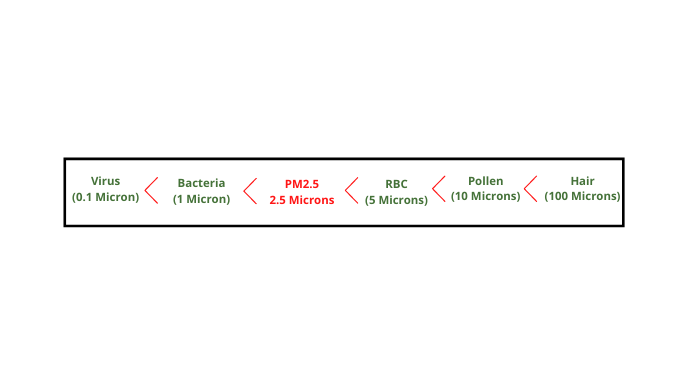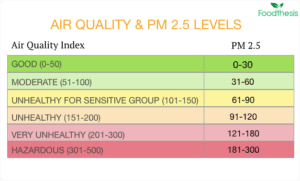What is PM 2.5?
Particulate matter is also known as PM or particle pollution is generally fine particles present in the atmospheric air which causes pollution. These particles vary from ashes, liquid droplets, and other suspended material in the air which does not get settled easily. Fine particles are mainly of two major sizes, the particle size with 10 micrometer or microns is known as PM10 and the particles with size 2.5 microns are known as PM2.5. The following article thus discusses What is PM 2.5? and its side effects on humans.
How are small PM2.5 pollutants?
PM 2.5 particles are smaller than the red blood cells (5 microns) and are larger than the bacteria (1 micron). These particles are so small that they act almost like gas and penetrates deep into the lungs and get deposited there causes serious lung disorders.
Sources of PM2.5 pollution
Primary sources of PM2.5 emission are vehicle exhaust, incomplete combustion of wood or farm byproducts, forest fire, cooking, and dust.
The secondary sources are the chemical reactions of gases like sulfur dioxide, nitrogen oxide, and nitrogen oxides, etc.
Why is PM2.5 so dangerous?
The level of PM2.5 should be considered seriously. Studies showed that an increase in PM concentration leads to direct mortality of the population (3).
Another study (4) done in European countries pointed out that exposure to PM pollution causes a decrease in lifespan by 8.6 months. An increase in PM2.5 leads to several diseases that are classified into short-term and long-term diseases.
How PM 2.5 impacts our health?
1. Coughing and chest discomfort
Breathing in the polluted air causes throat irritation, coughing, and chest discomfort with shortness of breath.
2. Irritation of eyes
Eyes become itchy as the particles hinder the tears production of glands and therefore lack of moisture causes eye irritation and redness with occasional swelling.
3. Irritation of nose
People exposed to high PM levels also experience upper respiratory tract irritation, running nose, and difficulty in breathing.
4. Irritation of the throat
On contact with a high PM2.5 level causes throat irritation. A sore throat and dryness are the two common symptoms.
5. Skin irritation
The PM2.5 particles cause oxidative damage to the skin and cause skin aging and allergies (1).
Long-term exposure to PM2.5 causes the following problems
1. A decrease in lung functioning
Prolonged exposure to high pollution significantly affects the lungs of children and senior citizens. Children have developing lungs and are more active therefore contact with pollutants causes more harm.
Senior citizens due to age have weak or undetected lungs problem are also get affected by high PM2.5 pollution.
2. respiratory-related diseases
The PM2.5 particles have the efficiency of penetrating deep into the lungs.
Prolonged exposure to high PM2.5 causes alveolar corrosion of the primary wall of the lungs thus leads to impaired lung functioning (2).
3. Cardiovascular diseases
Respiration in the air contains fine particles of 2.5-micron sizes also leads to many cardiovascular-related diseases.
Main cardiovascular diseases include disorders of the heart and vascular system that ultimately affect the brain leading to stroke (7).
4. Cancer
The research was done on exposure to long-term combustion-related fine particles showed increases in the risk of lung cancer (5).
Another study done by the American Cancer Society concluded that death due to lung cancer increases by 15–27% when PM2.5 air concentrations increased by 10 µg/m3 (6).
5. Premature death
Prolonged exposure to high levels causes premature death for those who are having respiratory-related diseases or having heart-related diseases.
Precautions to take in case of high PM 2.5 levels
- Wear eyeglasses during high PM levels of the air.
- Avoid using lenses during high pollution levels.
- Drink as much fluid as you can to keep the body and eyes hydrated.
- Avoid physical activity that makes fast and deep breathing.
- Keep all the windows and doors close to avoid minimum contact with the outside air.
- Use an air purifier in homes or at least in the room where you stay maximum
- Wet mopping avoids vacuum cleaners or brooms.
- Use mask specifically N95 and P100 respirators outside the house.
- Avoid smoking and indoor burning of woods.



I was able to find good information from your blog articles.
Im obliged for the blog article.Really thank you! Awesome.
… [Trackback]
[…] Informations on that Topic: foodthesis.com/what-is-pm-2-5/ […]
[…] sea sprays, and recovery of organic matter in the leaves. The first of these products mainly PM2.5 and the second is produced mainly PM10. Mineral dust has both natural and human sources. It can be […]